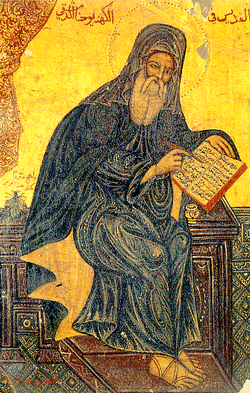 |
| John Damascene |
He received an education in Greek and Arabic but gave up his position in government and retired to the monastery of St. Sabas in the Judean desert. He was eventually ordained a priest. John was active during the iconoclast controversy of the Byzantine emperor Leo the Isaurian (717–741 c.e.).
John strongly defended the ancient Christian practice of veneration of holy images and composed in his Three Orations a reasoned defense of this practice. His work supported the later defenders of the veneration of icons following the Second Ecumenical Council of Nicaea (787 c.e.). Since John was outside the Byzantine territory he could continue to write against iconoclasm and the iconoclastic Byzantine emperors without fear of reprisal.
His monumental work is the Fount of Knowledge, a collection of Christian knowledge in three parts. The first book, the Dialektika, is essentially a definition of philosophical terminology. The second is a compilation of heresies based on the Panarion of Epiphanius, the bishop of Salamis in Cyprus (c. 315–403 c.e.).
The selesai section and the core synthesis of the work is entitled On the Orthodox Faith (De fide orthodoxa), a summary of doctrinal positions on a wide array of theological topics designed to help Chalcedonian Christians respond to claims of Islam and other Christian churches. The theology of these responses is a summary of earlier Greek theologians.
The most important figures in this summary are Gregory Nazianzen, Athanasius of Alexandria, and the Latin theologian Leo the Great of Rome. Since the theology of Jesus (Christ) of Nazareth’s human and divine natures was the area of greatest disagreement among Christians, John addresses many doctrinal concerns in this area.
On the Orthodox Faith was translated into Slavonic in the ninth century c.e. and into Arabic in the early 10th century c.e. Latin translations were made in the 12th and 13th centuries c.e., and Thomas Aquinas cited On the Orthodox Faith in the Summa Theologiae with significant frequency.
John composed the earliest Christian apologetic literature in Greek addressed to Islam, although it is uncertain to what form of the Qur’an he had access. The influence of John was immediately felt on the Syriac theologian Theodore Abu Qurra’ (fl. 780–820 c.e.), another monk of St. Sabas, who wrote defenses, of the veneration of images and apologetic literature addressed to Islam in Arabic, Greek, and Syriac, although only his Arabic and Greek writings survive.
John made substantial contributions to the development of the Byzantine liturgical offices. The system of daily and weekly hymnography based on 12 tones in Byzantine liturgy known as the Octoechos is attributed to him. In addition, he composed hymnography for saints’ days and for other occasions; a good portion of this material is still sung as part of the Byzantine liturgy today.
EmoticonEmoticon